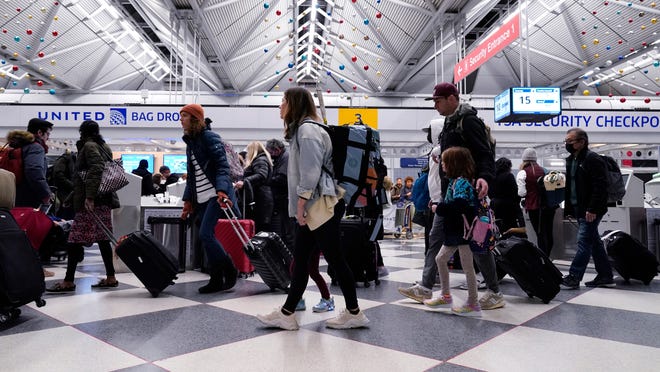[ad_1]
The death toll from a historic onslaught of winter weather across the U.S. rose to at least 48 Monday as frigid arctic air and heavy lake-effect snow left large swaths of the U.S. frozen.
The pre-Christmas winter storm left at least 27 dead in western New York — one of the worst weather-related disasters in the region’s history after the area was pummeled with as much as 43 inches of snow.
The dead have been found in their cars, homes and in snowbanks. Some died while shoveling snow. The death toll across the country was expected to rise as many remained without power in the frigid temperatures and hazardous road conditions continue.
Buffalo, New York has seen some of the worst damage from the storm, including hurricane-force winds and whiteout conditions from snow that left emergency response vehicles stranded on highways and roads.
Erie County Executive Mark Poloncarz called the storm one of the worst he’s ever seen during a Monday news conference.
“This is a once-in-a-lifetime, generational blizzard,” he said of the impacts to the county, which includes Buffalo. “And this is not the end yet.”
While warmer temperatures are forecast for later in the week, the area is still expected to receive six to 12 inches more of heavy, lake-effect snow between Monday and Tuesday, according to the National Weather Service station in Buffalo. Lake-effect snow develops from narrow bands of clouds that form when cold, dry arctic air passes over a large lake. It can last anywhere from a few minutes to several days.
Much of New England and the Eastern coast will remain in a deep freeze until more moderate temperatures arrive Tuesday, the NWS said Monday, and lake-effect snow could continue to cause travel hazards until they slowly improve later in the week.
MORE:Buses with migrants have dropped off outside of VP Harris’ house before. Why Christmas Eve was different.
Snowstorm is Buffalo’s worst in 4 decades, rivals historic 1977 storm
Officials in Erie County compared the storm to what is widely known as Buffalo’s worst blizzard in January, 1977, which saw surprisingly little snowfall but brought sustained, deadly cold temperatures into the area for weeks.
Only 12.3 inches of new snow fell at the Buffalo Airport during the 1977 blizzard, according to the Northeast Regional Climate Center, compared to more than 40 inches in this week’s storm. Blizzard-condition winds occurred for nine consecutive hours and zero visibility lasted for 13 consecutive hours.
Powerful winds instead blew loose snow from previous storms that winter from frozen Lake Erie onto land, creating huge snowdrifts and fully burying houses and cars alike.
In the 1977 storm, 29 people died in four days, including 12 who were found frozen in stranded cars, the Associated Press reported.
“This is a horrible situation,” Poloncarz said Monday of the 2022 storm. “The blizzard of 1977 lasted longer — it lasted three days of terrible conditions, this was two days of terrible conditions — but the ferocity of the storm was worse than the blizzard of 1977.”
Relief on the way? Forecast for warmer temperatures, power restorations
Over the holiday weekend, extreme weather stretched coast to coast and from Canada down to Mexico. In total, about 60% of the U.S. population faced some sort of winter weather advisory or warning, with temperatures plummeting drastically below normal in many areas.
But forecasts for the days leading up to the New Year show some promise of warmer weather relief. Residents in the Buffalo area and swaths of the country can expect warmer temperatures in the later portion of the week, according to Tom Kines, a senior meteorologist at Accuweather.
“The trend is going to be for warmer weather for the upcoming week. In fact, Buffalo could easily get up in the 40s at some point during the second half of the week,” Kines said.
Meanwhile, power outages from coast-to-coast continued to be steadily restored Monday, addressing some concerns for residents trapped in their homes without electricity and heat. Fewer than 100,000 customers were still without power as of 9:15 a.m. EDT Monday, according to poweroutage.us, down from a peak of 1.7 million.
Even with steady progress on power restorations and storm cleanup, more than 2,400 flights were cancelled within, into, or out of the U.S. for Monday, according to FlightAware.
Flight delayed or canceled?:What you need to know and what airlines owe travelers.
From New York to Kentucky, death toll rises across US
Car crashes, falling branches, falls through river ice and carbon monoxide poisoning all led to deaths in different parts of the country because of the winter weather.
In Niagara County, a 27-year-old man was overcome by carbon monoxide after the high snow drifts blocked his furnace, and in Ohio, a utility worker died after being electrocuted while working to restore power during the storm, local outlet WTAP reported.
Six motorists were killed in crashes in Missouri, Kansas and Kentucky, and a Vermont woman died after struck by a falling branch. Police in Colorado said they found the dead body of a person who appeared to be unhoused while the area was experiencing subzero temperatures.
Dig deeper
Contributing: The Associated Press; Joel Shannon, Wyatte Grantham-Phillips, Marina Pitofsky, USA TODAY

[ad_2]
Source link
